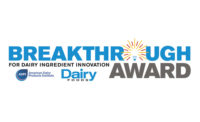Each year, the Elmhurst, Ill.-based American Dairy Products Association (ADPI) and Dairy Foods put the spotlight on dairy ingredient accomplishments by honoring a dairy processing member of ADPI with the Breakthrough Award for Dairy Ingredient Innovation. However, this year we thought we would shake things up a bit by honoring two deserving companies — in two different innovation categories — with 2021 Breakthrough Award honors.
A dairy-based alternative to traditional sports drinks
One of those companies is GoodSport Nutrition, a Chicago-based startup that is being honored in the “innovative milk-derived or whey-derived dairy ingredient products” category. The company introduced the GoodSport sports drink line earlier this year. The first-of-its-kind beverage line “rescues and upcycles” the nutrient-rich milk permeate resulting from milk ultrafiltration by dairy processors to create products such as cheese, explains Michelle McBride, the company’s founder.
GoodSport beverages provide three times the electrolytes and 33% less sugar than traditional sports drinks, McBride notes. The beverages, made with only natural ingredients, are a good source of calcium and an excellent source of B vitamins. They are also lactose-free and shelf-stable.
The products were born out of the frustration McBride had with the traditional sports drink category. She did not want her son to drink the artificial ingredients-containing sports drinks being offered at his baseball games and had been providing him with chocolate milk instead.
McBride’s initial research led her to a large study that demonstrated milk is more hydrating than traditional sports drinks. Thus, she began a quest to create a highly effective sports drink from milk.
“Milk is a natural source of the essential electrolytes and carbohydrates needed to provide effective hydration,” she says. “Scientific studies have shown that milk hydrates better than traditional sports drinks and water. However, milk’s consistency and protein content, which is slow to digest, were barriers for athletes before and after exercise.”
To bring the idea to life, McBride says she engaged with experts in sports nutrition and from across the dairy industry. For example, Bob Murray, Ph.D., co-founder and former director of the Gatorade Sports Science Institute, oversaw product formulation and ensured product attributes were based in well-established hydration science. And Kimberly (K.J.) Burrington — who was with the Center for Dairy Research at the University of Wisconsin in Madison at the time and now is director, training, education and technical development for ADPI — helped to create a consumer-expected mouthfeel and more.
“K.J. showed the team how ultrafiltration can be used to harness milk’s electrolytes, vitamins and carbs to create a clear beverage,” McBride explains.
The resulting product line retails online in packs containing a dozen 16.9-ounce bottles on GoodSport.com and Amazon.com in Lemon Lime, Fruit Punch, Citrus and Wild Berry flavors. It soon will roll out in select Midwest brick-and-mortar retail stores, too, McBride says.
GoodSport beverages have been “very well received” so far among both sports nutrition professionals and athletes, she adds, offering up a quote from Leslie Bonci, MPH, RDN, CSSD, LDN, sports dietitian for the Kansas City Chiefs:
“Until now, athletes have had to choose between a sports drink with effective hydration or one with natural ingredients,” Bonci says. “Now we have a natural sports drink that’s effective, efficient and evidence-based.”
Method for A1, A2 b-casein detection
Our other 2021 Breakthrough Award winner is Eurofins DQCI. The company is being honored in the category of “innovative breakthroughs in R&D or quality assurance of dairy ingredients.”
Eurofins introduced a new method to detect and distinguish the A1 and A2 b-caseins in most dairy matrices, including fluid milk, cheese, yogurt, powder and infant formula, explains Dino Holmquist, M.Sc., Ph.D., vice president of business development for the company. (A1 and A2 b-caseins are differentiated by only a single amino acid.)
Although A2 dairy products are relatively new to the U.S. market, strong growth is forecast for this segment in the coming years, Holmquist notes.
“There are numerous scientific articles describing the health benefits of A2 products over A1, including self-reported lactose intolerance, which in many cases was shown to be intolerance to A1 b-caseins, but not the A2 b-caseins,” he says. “A2 dairy products have also shown other health benefits on intestinal function, stomach discomfort and inflammation.”
The introduction of the new method is significant. Prior to it, the only traceability for A2 products was from the genetic profile of individual cows to the consumer. And with frequent replacement of cows in a herd, there has been a high risk of contamination of A1 b-casein in dairy products marketed as A2, Holmquist explains.
“The new method is based on mass spectrometry and is qualitative, meaning the results can be used as a batch release or confirmation of labeling claims,” he says.
Very sensitive, the method is able to detect levels down to 0.01% of A1 and A2 b-caseins. That is more than sufficient to satisfy current standards for products being marketed as A2, Holmquist says.
“There is currently no regulatory definition of A2-marketed products; however, with this new analytical method, some grocery chains have their own internal limits for these products,” he adds.






